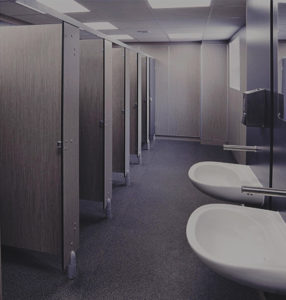05Feb2021
Washroom Cleaning: 5 Areas – You Can’t Miss
Maintaining high-traffic common areas within a facility such as washrooms is critical. Washroom cleaning takes time and attention to detail. Due to the aerosol effect that occurs when a toilet is flushed with the lid open, harmful bacteria can easily spread throughout a restroom. However, the toilet is not a restroom’s most unsanitary place. Many different surfaces harbor bacteria. In addition to toilets, it’s important to clean and disinfect the following restroom high-touch surfaces to prevent germ transmission:
1. Door handles
Door handles are oftentimes unavoidable. With each entry and exit, germs are transferred from restroom users’ hands to the handle and vice versa. Cleaning and disinfecting restroom door handles regularly will help mitigate the spread of germs throughout facilities.
2. Dispensers and dryers
Not all restrooms include touchless soap and paper towel dispensers. Dispensers without touchless features may harbor more bacteria and viruses. Clean and disinfect “push” dispensers if touchless installation is not feasible. Air dryers can spread germs throughout a restroom.
Providing paper towel dispensers can be one way to help patrons and employees dry their hands without spreading germs. Consider placing the paper towel dispenser near the exit so they can use a paper towel to grab the door handle when exiting a restroom. Install a trashcan next to the exit so they can easily throw the used paper towel away before leaving the restroom.
3. Light switches
Washrooms with manual light switches this is essential. With a focus on door handles, floors, and toilets, light switches can often be overlooked when cleaning and disinfecting. Make sure they receive proper attention too.
4. Grab rails
Rails should be cleaned frequently using a microfiber cloth, avoid using abrasive tools and solutions. For example, using steel wool or mineral acids and bleach may cause the rails to rust. Additionally, if you use disinfectant solution, follow proper label instructions. It’s important to know the dwell times of disinfectants as well as if the solution should be wiped off or can air dry.
5. Washroom stalls
When cleaning door latches, toilets, and floors, don’t ignore restroom stall walls, which may be covered in bacteria spread from toilet plume. Overlooked stall walls can have a build up of germs.
Washroom cleaning best practices
When deep cleaning and disinfecting high-touch surfaces in restrooms, it’s critical that facilities follow best practices.
Proper disinfection requires proper washroom cleaning before disinfection. Cleaning will decrease dirt, germs and other impurities on high-touch surfaces, and disinfecting will kill or inactivate the germs on the surface. If high-pressure cleaning and extraction is not available, using separate brushes, hand tools, microfiber wipes, and a dual-chamber mop bucket will help reduce cross-contamination.
Staying educated and following instructions: Aside from using proper cleaning protocols, it’s important to stay educated on the products used and follow manufacturers’ directions. For example, some disinfectants may have a contact time of 10 minutes, while others may only require three minutes.
Best practices that clean high-touch points in common areas like restrooms are important to limit the spread of germs. As Edmonton businesses work hard to provide clean and safe facilities in the COVID-19 era, it’s more important than ever to establish and adhere to strict cleaning protocols.
Contact Bluebird Janitorial today, let us take care of restroom cleaning needs. https://bluebirdjanitorial.com/contact-us/
